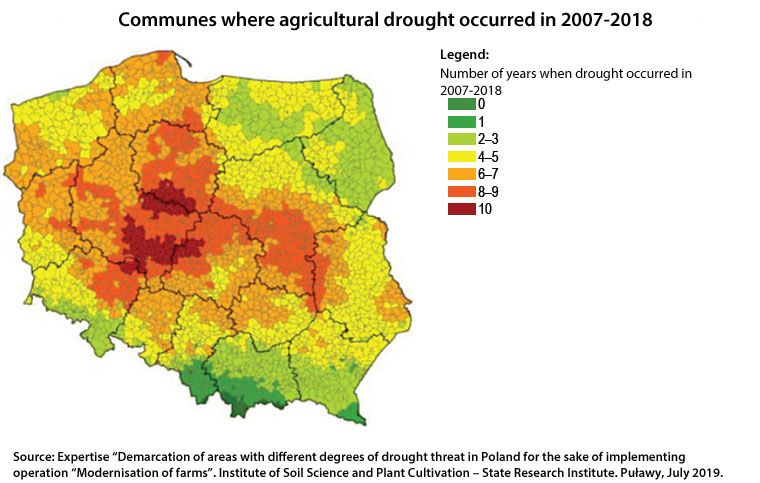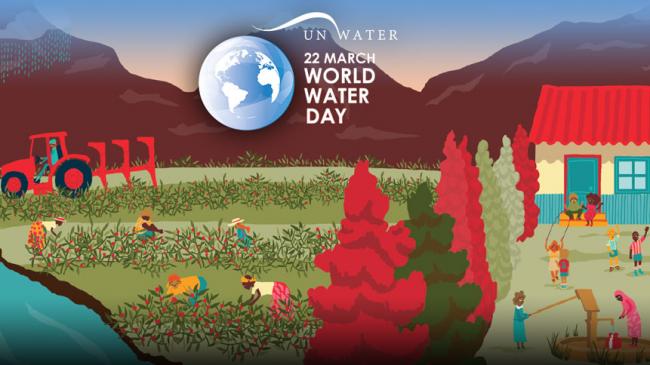The drought in the Polish agriculture is not a new phenomenon. But in the past years its frequency has increased. The drought started to cover large areas of our country almost every year – in 2015, 2016, 2018, 2019 and in 2020. Water shortages resulted in losses in agricultural production and thus state aid proved essential for aggrieved farmers. In 2015, subsidies provided by the state totalled about PLN 500 million but in 2018 it was already four times more (a bit more than PLN 2 billion) and in 2019, it was nearly PLN 1.9 billion.
There is still no coherent concept in place to ensure strategic and system-based approach to water management in agriculture. Forecasts show that the problem will intensify. The soil is going to be drying out continuously and so the drought threat may grow, especially in Western and Central Poland.
Little resources
Norway, Sweden and France are countries with the largest resources of surface water and groundwater (371 billion m3, 196.5 billion m3 and 191 billion m3 respectively). Poland is a poor country in that respect. Our water resources oscillate around 60 billion m3 on average and in dry seasons 40 billion m3 maximum. This is 1600 m3 (1.6 dam3) per inhabitant (1 decametre3 = 1000 metres3), whereas in most European countries fresh water resources usually exceed 5000 m3 per inhabitant (5 dam3).
The biggest consumer of water resources is agriculture which absorbs approximately 70% of its world resources (industry 20%, households 10%). Poland, although located in a moderate rainfall zone, has scarce water resources for agriculture at its disposal. Periodically water deficits cover ¾ of the area of Poland.

Insufficient retention of local catchment areas is a problem. One of the reasons behind is increasing amount of impervious surface in Poland resulting from urbanisation and development of transport infrastructure. Other reasons include changes in agricultural production and excessive acceleration of water discharge from catchment areas and river valleys.
Currently the total quantity of water in storage reservoirs is about 4 billion m³ which is only about 6.5% of the average annual river discharge. It should be stressed that physical and geographic conditions of Poland make it possible to retain 15% of the average annual river discharge.
Water management
On 1 January 2018, with regard to the water law reform required by the EU, water management tasks were taken over by a new institution – State Water Holding Polish Waters. In 2018-2019, no tasks dealing exclusively with the prevention of water deficits in agriculture were planned there. Also, no separate funds were earmarked for that purpose. Some measures were taken, though.
The number of tasks related to the prevention of water deficits in agriculture varied strongly, depending on the region. As for investments in that area, in individual Regional Water Management Authorities they made up from 0% to around 70% of all investments.
Only at the beginning of 2020, in the face of another drought threat in agriculture, Polish Waters developed Assumptions to the Programme for shaping water resources. They provided for investments to increase retention in rural areas.
Until 11 September 2020 when NIK audit came to an end, none of 148 investments to be carried out by 2022 (apart from formal-legal preparation), were completed.
The NIK audit also showed that Polish Waters did not ensure proper conduct of administrative proceedings related to the maintenance of irrigation and drainage devices. An ordinance concerning that area was issued with one year’s delay. The reason was ineffective cooperation between the Minister of Marine Economy and Inland Navigation and the Minister of Agriculture and Rural Development.
Changes in law, financial support for farmers and education
In the audited period, there were three entities responsible for water management: the Ministry of Marine Economy and Inland Navigation, the Ministry of Agriculture and Rural Development and State Water Holding Polish Waters. However, only in the Ministry of Agriculture and Rural Development there was a unit dedicated to water management for agriculture (Water Management and Climate Department). There was only one employee responsible for that area, though.
As a result of efforts taken by both ministries, requirements for investments in small retention and irrigation in agriculture were simplified. Amendments were made to two acts: Water Law and Construction Law.
The ordinance of the Minister of Agriculture and Rural Development of August 2019 provided an opportunity to apply for subsidies for investments increasing retention and for irrigation in agriculture.
In 2019 and 2020 (as of 30 September 2020), farmers filed nearly 1.5 thousand applications for over PLN 118 million subsidies. Nearly 1100 applications were reviewed but only 67 contracts were signed for nearly PLN 4.2 million and more than 1000 applications were declined.
Also as part of the Programme for the Development of Rural Areas, water companies were granted subsidies for the purchase of irrigation and drainage devices (the total of 253 devices for PLN 24 million).
Prevention of water shortages in agriculture was also fostered by training programmes in water law and rational water management for farmers, as well as information and education activities. For instance, Polish Waters organised campaign called “Stop the drought”.
The Ministry of Agriculture and Rural Development published information materials about water saving and management on its website, as well as in TV and radio agricultural programmes.
Recommendations
In view of the audit results, as well as considering the state’s tasks in water management, including prevention of water shortages in agriculture, NIK has addressed the following recommendations:
to the Minister of Infrastructure and the Minister of Agriculture and Rural Development:
- to work out solutions to prevent water deficit in agriculture taking account of essential tools and mechanisms;
- to educate farmers and raise their awareness on adequate water management.
to the President of State Water Holding Polish Waters:
- to urgently implement nationwide a standardised method of keeping register of irrigation and drainage devices in the telephone and IT system with the aim of improving water management in rural areas;
- to ensure proper performance of tasks related to the conduct of administrative proceedings concerning the obligation to maintain irrigation and drainage devices.


